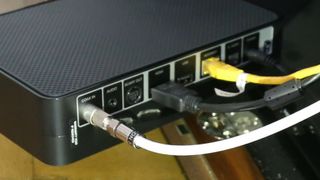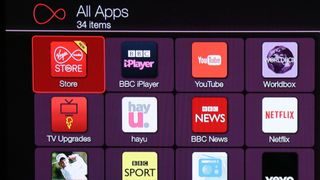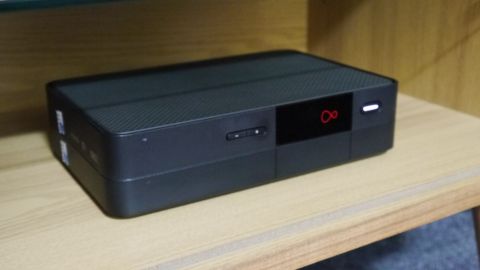TechRadar Verdict
After yonks with a super-slow set-top box, the V6 is fast and now in 4K. However, with few new features and little exclusive content, multi-room is the only thing to get excited about.
Pros
- +
Processing power
- +
Powerline-powered multi-room
- +
Six TV tuners
- +
TV Anywhere app
Cons
- -
Tivo seems outdated
- -
Fiddly menus
- -
Token 4K content
- -
SeriesLink+ is hit-and-miss
Why you can trust TechRadar
For a company that’s obsessed with its broadband speeds, the wait for Virgin Media to upgrade its ageing TiVo set-top box has been frustrating. Like most of its customers, for the past few years we’ve been able to download files in my office in seconds over a 150Mbps+ fibre-optic broadband network. However, moving into the lounge has meant taking yonks to even change a channel on the old TiVo box. It was all a bit embarrassing.
So the arrival of the new V6 set-top box is something of a relief. It’s almost always super-fast, and will instantly remove any frustration existing Virgin Media TiVo customers have with lagging. Ten times faster than that previous black box of doom, it comes with a 1TB hard disk as standard (no 500GB option this time) and can cope with 4K and HDR content. Best of all, it does multi-room if you have two boxes (or keep the old one), and it can record six programmes simultaneously, which should be more than enough for anyone. Add a new remote and a new SeriesLink+ system that attempts to better integrate on-demand content, and the V6 is an exciting proposition. But is it any good?
Design, setup & installation
The V6 is tiny. Measuring a compact 230x153x55mm and weighing 1.04kg, it will easily fit under – or even alongside – any TV. Inside is 3GB RAM and a Mediatek OctaCore, while on the rear is an HDMI 2.0a output with HDCP, an optical audio output, a 3.5mm mini-jack for analogue audio, and a Ethernet LAN port. There's also a USB 2.0 slot marked 'for future use'.

Installation is pretty simple; the engineers will do it for you. However, if you're going to keep your old Virgin Media set-top box – and I recommend you do despite how slow it is – it's worth knowing a few things. During the installation we (the engineers and ourselves) found that the V6 is instantly compatible with Powerline, the system that allows you to send data around your home’s electricity cables. Excited? You should be. If you do have Powerline plugs, or if you have Ethernet LAN points and/or routers around your home, you can network the V6 with your old set-top box. It’s possible you want the old Virgin Media set-top box out of your sight immediately, but if you can live with it in another room, do so. Why? You get to watch recordings made on either box in either room.
Remotes
There are two kinds of remotes for the V6; new hardware and a slightly improved smartphone app. The former is a lighter, sleeker version of the old TiVo remote, which now uses radio frequency (RF) instead of line-of-sight infra-red (IR). That tech also powers a ‘find me’ option – hit a button on the set-top box itself and the remote will beep.
The other option is to use the TV Anywhere app, which users of the old Virgin Media set-top box will be familiar with as being by far the quickest way to do anything. It's lost its speed advantage, but searching TiVo and manipulating recordings remains easiest on the TV Anywhere app.
The TV Anywhere app also enables two phones or tablets to work as a ‘second screen’ for watching some channels live over WiFi (notable exceptions being HD and +1 channels) and even the watching and/or downloading of some recordings. However, in practice the recordings don't always always play on a phone – the app just hangs – and in our test we were unable to download anything but episodes of Aussie soap Neighbours. So don't bank on making recordings on your V6 to later take away with you; it's technically feasible, but practically impossible.

The apps allows remote recording when you’re away from base, and it works really well. However, because it zeroes itself every time there’s an app update, or if a phone has an update, there’s often a huge amount of admin involved seemingly every time you use it. We found we only needed the app very occasionally, usually when we were out with friends who'd mention something on TV we meant to watch. That’s no time for data-entry and password-retrieval emails.
It's also worth knowing that the SeriesLink+ feature (discussed later in this review), which lines-up links to all kinds of on-demand content besides manual recordings, is absent from the TV Anywhere app.

Apps
Apps on the V6 are generally mediocre. They’re time-consuming to find while you’re watching TV, but at least the many button-presses and cursors slides are far quicker than before. Loading times for the likes of Netflix, YouTube and all terrestrial TV catch-up apps such as the BBC iPlayer (alongside dozens of apps you will never use) and quick enough, though the grid you have to trawl through does feel outdated. We've also had an occasional issue with the BBC iPlayer app refusing to load, which took us back to the pre-V6 days.
There's also an issue with navigation; years ago, the Netflix app was installed as a red button app to channel 204 on the TiVo EPG. A classic stop-gap, yet that’s still the quickest way to access Netflix. There's no Amazon Video app – blame the Fire Stick for that – though Virgin makes surprisingly little of its Sky on-demand content, which is fully integrated into the V6.
Jamie is a freelance tech, travel and space journalist based in the UK. He’s been writing regularly for Techradar since it was launched in 2008 and also writes regularly for Forbes, The Telegraph, the South China Morning Post, Sky & Telescope and the Sky At Night magazine as well as other Future titles T3, Digital Camera World, All About Space and Space.com. He also edits two of his own websites, TravGear.com and WhenIsTheNextEclipse.com that reflect his obsession with travel gear and solar eclipse travel. He is the author of A Stargazing Program For Beginners (Springer, 2015),


